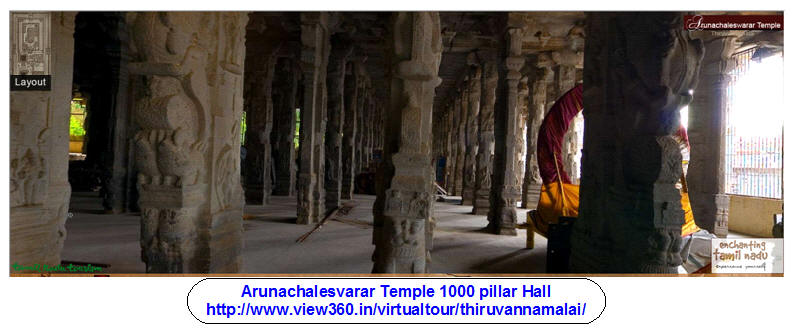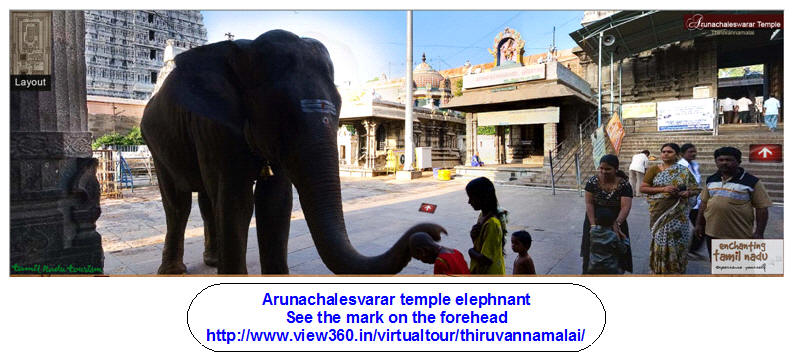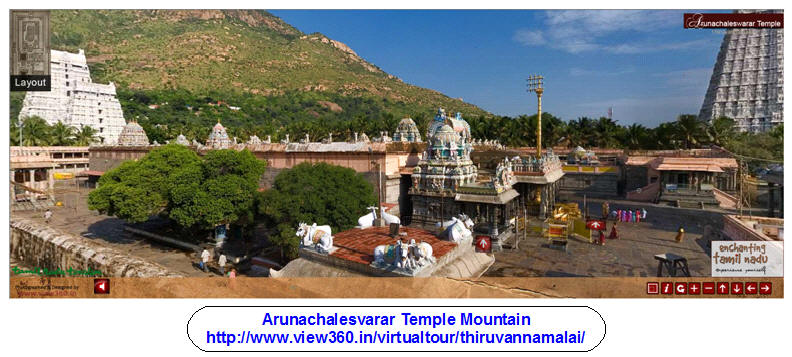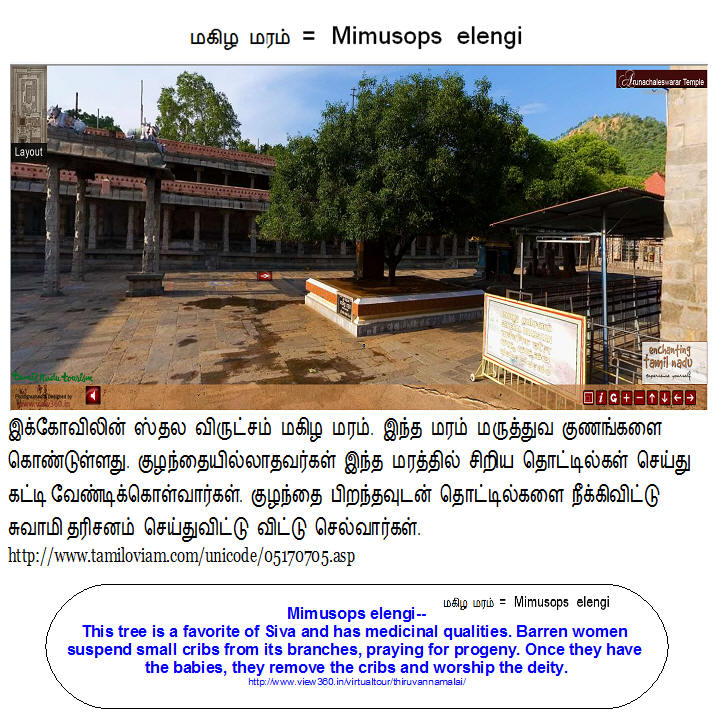Bhagavadgita Pages, Chapters 1 to 18
BG01 BG02 BG03 BG04 BG05 BG06 BG07 BG08 BG09 BG10 BG11 BG12 BG13 BG14 BG15 BG16 BG17 BG18
V.Krishnaraj
You have your Google search engine tailored for this site.
Please enter the word(s) in the search box; it will take you to the file with that word in this web site. Enjoy your visit here.

The
Sonachala
Arunachala
Introduction: The temple town goes by the name Tiruvannamalai. Please click the link to read the presentation of Tamil Nadu State Government on Tiruvannamalai.
http://www.tiruvannamalai.tn.nic.in/
http://www.view360.in/virtualtour/thiruvannamalai/
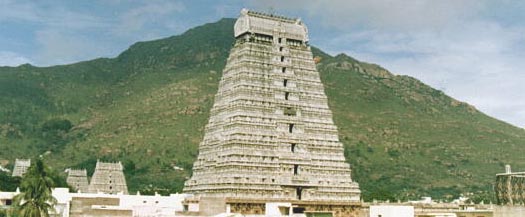
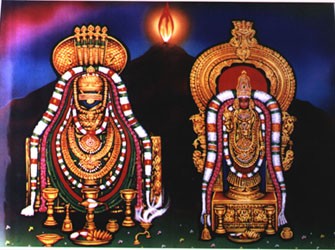
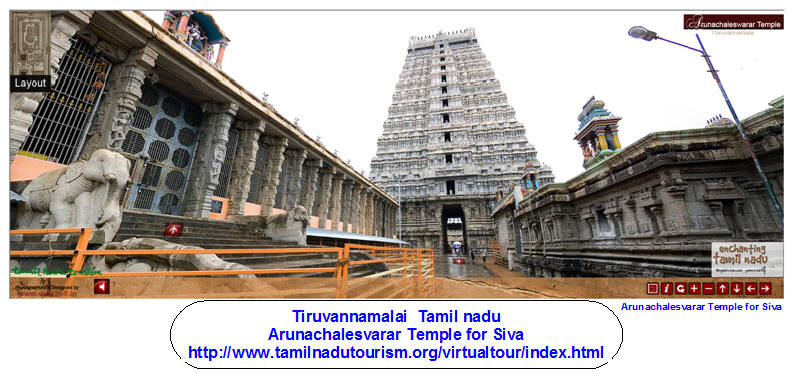
Annamalai and UnnAmulai
Source: Tamil Lexicon
Unnamulai = ¯ñ½¡Ó¨Ä = Parvati, worshipped in the shrine at Tiruvannamalai.
TiruVannaMalai = Tiru + Annal +Malai = Holiness + God + Mountain.
Annan = Elder brother. அண்ணாளன் = AnnAlan = hermaphrodite = Androgyny (Ardhanarisvara)
Annal: 1.Greatness, exaltation, loftiness; பெருமை; 2. Superiority - தலைமை; 3.King; அரசன்; 4.Great man, superior; பெருமையிற் சிறந்தோன்; 5.Ruler in a forest-pasture tract; முல்லைநிலத் தலைவன்; 6.God, deity -- கடவுள்; 7.Master, lord; தலைவன்; 8.Father--தந்தை; 9.Preceptor, spiritual guide -- குரு; 10. Siva; சிவ.11. Arhat; அருகன். 12. Elder brother; அண்ணன்.
Annāl = unapproachable + Malai = mountain.
Annāl carries several meanings: Siva's other name, unapproachable (mountain); Androgyny.
There is no mention in the literature except in the Tamil Lexicon of Madras University that Annāl also means Androgyny. All three meanings can be applied to TiruVannaMalai.
1. Siva is the sacred God of the hills.
2. Siva as a fiery Lingam-mountain was unapproachable because of the heat.
3. Siva is an androgynous God.
The last meaning is introduced by me, worthy of comment by erudite Tamil scholars.
Siva appeared as a fiery Column with no ends in sight to teach humility to Brahma and Vishnu, who, searching for its ends in vain, accepted their foolishness and recognized Siva's greatness. Siva granted the request of Brahma to cool down his fiery Lingam for it was scorching the earth, living beings and plants; it became a stationary object (Arunachalam = red Mountain) for worship and circumambulation of the eight-mile long base (of the mountain--Giri pradakshinam). The burning column thus became the mountain of Tiruvannamalai, 2682 feet high. To mark the Great Event, Krittikai Deepam is celebrated every year around the middle of December. A large copper cauldron of ghee (clarified butter) with a burning wick on the top of the mountain marks this occasion which coincides with the full moon; the flame goes on for ten days. Lord Siva manifests as the five elements, which coalesce to become one entity in Tejolinga (fiery Lingam--Krittikai Deepam; Kartikai [கார்த்திகை] is Lunar Tamil month) standing on the top of the mountain in the evening. This marks the end of ten-day festival of Brahmotsavam. Five earthen-pot lighted lamps represent the five elements and provide the flame for the single Bharani deepam which the fisherman carry to the top of the mountain for use as the source-light for Krittikai deepam (கிருத்திகை தீபம்).
. Parvati, Consort of Siva was born in a fishing village and so the fisherman received the privilege to light the lamp.
Cauldron is made of copper, ten feet in height and five feet in diameter with three rings at the rim on either side, for the poles to support the weight when carried up the hill. This unique privilege is given to the fishermen who take turns to heave it up the mountain. One of them lights it up.
Western authors on Siva are of the opinion the heat of the Lingam is the generator and destroyer of the universe.
Circumambulation of Siva is as important as Abhisekam (= அபிஷேகம் = Ritual bathing, ablution) of Vishnu. But another source tells that Siva likes ablution and Vishnu likes ornaments. Siva likes to wear perfect pearls around his neck and feet, golden breastplate on his chest and diamond-studded jewels, according to Umapati Sivachariyar of 1300 A.D, who sings praise of the Lord with curved raised Foot (= குஞ்சிதபாதம் = Kunchitapadam), though Siva wanders like a mendicant ready to protect and serve his devotees.
The
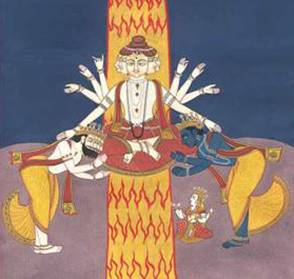

1: The Fiery Lingam with no ends in sight 2: Ramana Maharishi 3: Red mountain with temple in the foreground (see above)
The object of birth on this earth is not just for Bhoga (enjoyment) but to attain Mukti (liberation). To be born a human is to be on the top of the animal kingdom having excelled them in previous births. One cannot attain Mukti as an animal. There are five Mukti Sthalas (places).
1. Birth Mukti of Tiruvarur: It means that if your are born in Tiruvarur, you automatically attain Mukti (liberation).
2. Thought Mukti of Tiruvannamalai: If one thinks of Tiruvannamalai, one attains liberation.
3. Residence Mukti in Kanchi: If one lives in Kanchi, one attains liberation.
4. Death Mukti in KAsi: If one dies in Kasi or Benares, one attains Mukti.
5. Sight Mukti in Chidambaram: If one gets Dharsan (seeing) of the Dancing Siva in Chidambaram, one gets liberation.
Their official website is:
http://www.ramana-maharshi.org/
Skanda Purana on
●Sanaka, one of the mind-born sons of Brahma, knew something vaguely about fiery effulgence of Siva. He asked his father to tell him all that he knew about Siva. Hearing the name of Siva drove Brahma, seated on the lotus, into meditation on Sambhu. Sam + bhu = auspiciousness + Being = Auspicious Being, Siva. Brahma had visions of Sambhu and enjoyed internal bliss. Out of deep respect for his father, Sanaka waited by his side patiently. The four-faced Brahma saw a fiery column of fire in his vision, which had the same appearance when he saw it once before at the beginning of the world. He remembered with humility the last time he saw the fiery column with Vishnu by his side; it was at the beginning of creation, when Vishnu and Brahma fought with each other and Siva in his Grace had to show them the endless column of fiery Linga to prove his superiority. Sanaka noticed his father in tears and his hair stand on end. Slowly Brahma snapped out of his yogic vision, though his speech was tremulous and faltering. Brahma was praising Siva, saying that all sins vanished when a seeker moved among the devotees of Siva and joined in all their activities. As the cow has an eye on its calf and follows it like a shadow, Siva and Gauri follow the devotee who utters, "Mahadeva." Why is it that the consort of Bhavani, whose feet support the entire universe, follows the devotee closely? It is because Bhava wants to show that he and the devotee are inseparable. Bhavani = consort of Bhava. Bhava = Siva, Existence, life.
A digression: See what Vaishnavas think of Sambhu. Don't let this put you off. Siva and Vishnu express their appreciation of each other, eulogize each other in very effusive terms, and admit they are equal. The earthbound spin doctors (spinmeisters) jostling in the ocean of Samsara would have you believe otherwise. I (author) consider it my duty to present all points of view; the choice is yours to make or not to make.
(Skanda Purana, I.ii.3343-47: I am Hari and Hari is me; there is no difference between us; we are like two lamps; he who who hates him hates me; he who follows him follows me; he who knows this is my devotee. Author's note: This statement by Siva-Mahadeva eliminates any difference between Siva and Vishnu. That being so, why is there so much acrimony?)
Mahavishnu, according to Brahma Samhita, created Vishnu from his left limb, Brahma from his right limb, Sambhu, the manifest divine masculine halo, from glabella between his eyebrows. Sambhu is Siva, the transformed (and transmuted) power of Krishna or Mahavishnu delegated to bring destruction. Sambhu, it is said, originated from the diffuse halo of Mahavishnu. Sambhu is compared to curds (yogurt) that originated from milk after inoculation (with active cultures); Sambhu is svamsa (Vishnu’s own subjective entity, though contaminated or inoculated) of Mahavishnu. Svamsa = Sva + Amsa = own fragment. (subjective entity = alter ego of MahaVishnu.) In policy arena, Ms. Condy Rice is the alter ego of Mr. Bush. Now you can see the relative position of Mahavishnu and Sambhu.
Sambhu is a masculine principle from whom Rudra manifests. Sambhu is delegated by Mahavishnu to do certain tasks: material creation of the world, destruction of Asuras, and sublation. Sambhu is the guna avatara of Govinda: destructive principle. Sambhu collaborates with Durga in the performance of his duties with Kaala (Time element). He also helps Jivas attain liberation as mentioned in Tantra sastras. Brahma Samhita declares that Sambhu functions in accordance to Govinda’s Will to inculcate devotion in votaries according to Agamas. Sambhu is the Lord of Jivas. Brahma Samhita says in effect that the Consciousness of Sambhu is not the same Pure Consciousness (Chit Sakti) of Vishnu, Mahavishnu, Govinda or Krishna; however, Sambhu’s consciousness is superior to Jiva’s consciousness. Vishnu, though his guna avatara is Sambhu, is chock-full of Sattva; he has no contamination with mundane tattvas or categories. The lower forms or derivatives of Govinda or Krishna are analogous to transmittable light from one candle to the next, all abiding in the original spiritual light of Govinda. Siva, as a purveyor of Tamas guna and ignorance, is chock-full of soot and less of light; thus, he is not Pure Consciousness as are the forms of Mahavishnu. Brahma spews more soot in his candle than Sambhu and thus, Siva-Sambhu is superior to Brahma. The differentiating five attributes are purer in Siva-Sambhu than in Brahma, meaning that Siva-Sambhu is more divine than Brahma. Goddess Durga, according to Brahma Samhita, is the maid servant of Karanarnavasayi (Causal Ocean) Vishnu and performs her delegated work in conjunction with Siva Sambhu.
Another Version
Narayana and Brahma were the two sons of Sadasiva. They started fighting with each other not knowing the greatness of Siva; each one thought that he was the creator and preserver of the universe and beings. Sensing their foolishness and loss of memory, Siva thought that he had to show himself in such ways there was no disputing Siva was Paramatman and superior to all.
Sadasiva stood up and soon he was a column of fire with no ends in sight. They saw thousands of tongues of fire on the fiery column, which melted their confidence in themselves. Then there was a boom, a burst, and a thunder; an ethereal voice rose from the bottom and addressed them, "O children, your minds are deluded. You fight over something that you don't own. Your strength is abysmally feeble. Look at me, I am Sambhu. If you find the beginning and the end of my fiery column, I will declare you strong and superior to me."
Thus saying, fiery Sambhu stood there in supracosmic splendor with a million tongues licking the earth and the sky. The twosome stood there in wonder, shock, and awe, but their foolishness still clouded their thinking; they decide to stop fighting and look for the ends of the fiery column. They were acting like children wanting to grab the moon reflected in the water with their hands. Fiery Sambhu let them discover for themselves their delusion. Vishnu took the form a Boar and Brahma a swan. Vishnu dug the earth for millions of years; he only saw the column but not its beginning. His curved teeth showed signs of erosion and broke. His joints creaked, swelled and froze in agonizing pain. His body refused to move, overcome with terminal fatigue. The heat from the fiery column was scorching; his tongue was dry, and coated with mud; his thirst begged for water; his muscles ached; his mind was numb. Vishnu's feebleness was so extreme that he could not get back to his original form; his strength was hollow and his confidence was shallow; his glory faded; he felt like a rag; he could not get out of the hole he dug. Lord Vishnu, thus exhausted, can only think of taking refuge in Siva. He groaned, and bemoaned his "great stupidity and arrogance." With all humility at his command, he praised Siva, saying that Siva was his Lord, the source of Vedas, Devas, and the universe, that the beginningless Lord had no props, ends or roots to support him, while all his creations were rooted in him, that he was his son like everyone else, that he regained the knowledge of his soul and appreciation of the kindness of his dear father, Sambhu, that Sambhu, on his own accord, conferred perfect knowledge with modesty and grace to those he wished to protect, and that he dedicated himself to Sankara and sought his refuge. Thus saying, Vishnu meditated on Siva, while he was lying in the deep abysmal hole. The Lord of Goblins sent his minions to rescue Lord Vishnu and bring him to the surface of the earth.
(Sekkizhar in the verse 18 of his magnum opus, Periya Puranam says that Vishnu once came to worship the feet of Siva and did not find the auspicious time for the same. His Vahana or transport, Garuda (the mythical bird, whose head, wings, talons and beak resemble the eagle and the body and limbs the man) drifted off to a cave in the foothills of Kailas. There the Garuda saw the rodent vehicle of Ganesa, which assumed the white color from the radiant effulgence of Kailas and appeared in the likeness of pig (Varaha--Lord Boar Avatara), which seemed to confuse and delude the Garuda.)
As this was happening with Vishnu, Brahma was flying for many years higher and higher in the sky in his futile and childish attempt to find the upper end of the fiery column. His wings were losing the carrying power and his eyes were tired of looking here and there for the upper end of the column. As he was flying up and up, he came across some Siddhas, who were born of the effulgence of Siva, who spoke thus, about his futility: “Yes, it is true the son of Siva is busy in his stupid pursuit of finding the end which no one found. His arrogance is flying high as his wings are losing their holding power. Janardhana (Vishnu), by the grace of Siva, returned to earth from his travail. Brahma is born of the Self of Siva and now he wants to find its limits. It is hoped Siva comes to his rescue, restores his intelligence and ends his arrogance." Brahma, on hearing these words from Siddhas, realized his mistake; his pride came down to earth on its tired wings. His vast Vedic knowledge and wisdom, his penances, and pilgrimages to Tirthas (holy places) did not confer the perfect knowledge of Siva for he did not receive blessings from Siva. His wings were frazzled; feathers were hanging loose from the tired wings; feet lost their vigor and were numb from high altitude freezer burns. His wounded arrogance wanted to give up and seek the healing powers of the Great Atman. Brahma thanked the Siddhas for bringing him back to his senses. He realized the mighty benefits that came from contact with the Siva Siddhas. It took him so long to realize the greatness of Siva, though he was born of him and the Devas and other beings were born of him too. Nearness to him did not give him the intelligence to appreciate his father, Siva, whose subduing power is his benign Grace. (Tirtha = holy water, holy place near any body of holy water.)
As Brahma in the form of a swan was in search of the top end of the fiery Lingam, he noticed a flower falling down. Brahma immediately cooked up an idea to recruit the flower ( தாழம்பூ= ThAzham poo = screw-pine flower) to bear false witness that he saw the upper end of the fiery Lingam. Siva found out by his yogic vision that ThAzham poo told a lie on behalf of Brahma. Both were demoted to a lesser role; the flower is no longer worn by Siva and Brahma does not have a temple in his honor with no devotees to call his own.
Brahma sought refuge at the feet of Sambhu, whose wisdom even Vedas and
Agamas could not fathom. He went to Vishnu and addressed him thus: "We were
the heroes, at least we thought so. We became arrogant, though we were born of
Sambhu. Our father heard about our quarrel and used it to curb our arrogance,
confer his grace and reveal his greatness. He is the Lord of the Suras (gods);
he is Sadasiva, the giver of Grace; he is the fiery column, with no beginning
or end; he is the boat in the
●The fiery column, the pure
Bhulinga (terrestrial Linga), appears in the spiritual vision of his
devotees. The soul of the yogis serves as the mirror for the Bhulinga.
Brahma, thus learning lessons in humility and greatness of Sambhu, bowed down
to Siva and sat by his side. Vishnu, the cloud-colored Lord, spoke in the
voice of rumbling clouds, “The victory is yours, O Lord of the three worlds.
You hold
Suddenly, from the fiery column of great effulgence with
no ends in sight, came out the Lord who wore the crescent moon on his crest
and was of dark brown complexion with blue throat. He was holding an ax and a
fawn by two hands and by the other two hands he was conferring grace and
refuge. Siva spoke words of kindness and grace and assured them that they had
gained realization of Atman. He granted them the portfolios of creation and
sustenance. Siva was very happy with Brahma and Vishnu and told them that he
would bestow a boon of their wish on them. Brahma begged the Lord to withdraw
the extreme radiant heat that could scorch the earth and deprive the earth of
all living beings and plant life and to settle down as fixed Linga with the
name of Arunachala in
---------------------------------------------------------------------------------------------------------------------------
*When dissolution takes place, all the seeds for future use are stored there in the Arunachala mountain.* Read the story below.
LONGYEARBYEN, Norway
Feb 28, 2008: A vast underground vault storing millions of seeds from around the world took delivery of its first shipment Tuesday. Noah's Ark Seed Vault.
Dubbed the "Doomsday Vault," the seed bank on a remote island near the Arctic Ocean is considered the ultimate safety net for the world's seed collections, protecting them from a wide range of threats including war, natural disasters, lack of funding or simply poor agricultural management.
Norwegian musicians performed Tuesday as part of an elaborate opening ceremony marking the opening of the vault, located 130 meters (427 feet) inside a frozen mountain. Wangari Maathai, a Kenyan environmental and political activist who won the 2004 Nobel Peace Prize, placed the first seeds inside the vault, followed by other dignitaries.
-----------------------------------------------------------------------------------------------------------------------------
Siddhas leave their world, devas abandon the
Arunachalam = Aruna + Acalam = Red + Immovable, Mountain, immovable Linga
as the
Sonasaila = Sona + Acalam = Arunachalam =
Sonasalam = Sonagiri =
●How did the fiery Lingam cool down, so that people can come close to it? How did various Tirthas (sacred water) spring forth from the mountain? How did the mountain absorb the limbs? Gautama, the resident sage, answered all these questions. The mountain was all fire during Krta Yuga; it was studded with jewels in Treta Yuga; it was a mountain of gold in Dvapara Yuga; it was emerald mountain in Kali Yuga. During Krita Yuga, it was still a column of fire; the sages performed circumambulation, until the fire subsided. (This gives us an impression that it might have been a volcanic mountain.--Opinion from the West) The Suras (gods) offered sacrifice to the mountain, and worshipped the Lord. The waters took their origin from Fire, who is described as the father of water. The heated air drinks up water and is laden with moisture, just like the clouds. This was followed by precipitation and eventually by streams from the mountains. These are the sacred Tirthas. There are several Tirthas in the mountain. Another explanation says that while Nataraja was dancing, Ganges River spilt over the ground from his locks; where ever the water fell, it became a sacred river or Tirtha. Tirtha is sacred water and is the eponym for sacred places of pilgrimage. Aindra springs from the eastern face of the mountain and was holy enough for Sakra to expunge his sin of Brahmin murder. Brahmatirtha sprang from the southeastern face; by bathing in it, the fire-god expunged his sins of adultery with married woman.
(Since fire-god is the carrier and deliverer of fire sacrifices and offerings to the gods, he had access (like the milkman) to wives of gods and Rishis; he took advantage of his position and ravished their wives. Later people found out that the gods (much to their relief) accept offerings directly from devotees without the middleman, Fire god. Since Fire-god has the ability to burn things, people pray to him to burn all their Prarabdha karmas, so that they will get emancipation. Agni, the elemental god of the Aryans, is still an important member of the Hindu pantheon. Without Agni, there is no fire ceremony of any kind; everything will come to a stop in the temples, synagogues, churches and elsewhere. The votaries pray to Agni to confer them Tejas, Aiswaryam, and boons. Agni is the third eye of the three-eyed deities. The common prayer addressed to Agni is as follows: O Agni, take me on the virtuous path. Take me forward and confer on me Aiswaryam. Lead me in the path of Sanmarga [path of virtue, morality, good conduct, wisdom]. You are a Vidvan; You are omniscient and the knower of human miseries. So take me in a good path. Please expunge the triadic demerits [past, present and future sins] Hey, Agni BhagavAnE nama. This mantra echoes in Vaikuntham. More on Agni and Vaishnava view. Of all the Devatas, Agni is the visible one. So Agni Stotram is important. Agni means He leads us forward. He also takes us to a higher status than we enjoy now. He is Prohitan (priest), meaning he takes us forward and or upward and gives benefits. Pro = forward or upward [future]; Hitam = benefit. He confers benefits in the future. He is the emissary between God and man. He always gives good advice. Contrary or ill advice earns demerit and eventually the demerit goes to the ill-adviser. That is why Agni never commits any infractions. This view contradicts to another view expressed earlier. He appears to favor people who sing his praises and confers special privileges and rewards. The meaning of Agni is Vishnu. When you call Agni, you are calling Vishnu. Since Vishnu is the Antaryamin (Inner Guide) of Agni, Agni is Vishnu. Agni carries the oblations to the gods whose Antaryamin is Vishnu; therefore, the oblations go to Vishnu. The boons Devatas give to the devotees eventually come form Vishnu. Since Vishnu is the Antaryamin of Agni, Vishnu is the Ultimate Prohitan.)
Yama had a fear of Brahma's missiles; he got rid of his fear by dipping in the Yamya Tirtha of the southern face of the mountain. The sages scored a victory over goblins and vampires (Bhutas and Vetalas) by bathing in Nairrta of the south-west quarter. Varuna got back his Salyakosa (sheath of the lance) by bathing in Varuna Tirtha on the west side of the mountain. Vayu (air) received the status of life-sustaining vital breath, by bathing in Vayaviya Tirtha. Soma received a cure of his wasting disease (Phthisis, tuberculosis) by bathing in the Soma Tirtha on the northern side. Vishnu, by bathing in Vishnu Tirtha on the north-eastern side, was able to unite with his consort Sri.
When oblations are offered in the world, the
Tirthas (water) reach Siva, who keeps it hidden. Siva ordered his
devotee, Gautama, to make pilgrimages to Tirthas (sites of holy waters). He
traveled far and wide and saw many natural-born Lingas in the Tirthas. (These
are the oval or oblong smooth stones in the river, which resemble Linga.) He
performed holy rites and worshipped the Lingas wherever he found them. He came
to Arunadri after many travels; it was a Mountain Linga where the sages,
eating only roots and fruits, offered prayers to Sonadri. Lord Siva appeared
to Gautama and asked him to show the way he should be worshipped on the
terrestrial plane. Devas (gods) worship Siva as void (Sunya). Gautama told
Siva that he is unapproachable in his fiery form. Siva called
Visvakarma (Divine Architect) and asked him to
build the City of
Sakti: Northern side of Siva. Sakti is named here Apitakuchambal. Siva and Sakti are inseparable. She will have lining of the eyes with red. Another Sakti by name Bhuvinayaki shall be worshipped
Mahadeva and Agasuta. He, by his gesture, offers enlightenment and freedom from fear. He holds an axe in his hand and deer by his side. He, also known as Sambhu, has his consort Uma and his son Skanda by his side.
Sundaresvari will be the goddess of worship in the festival of Sakti.
Ganapati, the son of Siva and Parvati, will be worshipped at the beginning of the festival. He will be near Siva and offers food to increase the prosperity of the world.
Amrtesvara (Lord of Nectar) shall be worshipped. He is the expert in Tandava (wild dance of Siva).
At the door entrance, Nandi and Mahakala representing the Sun shall be worshipped.
On the southern side, Mothers and Vignasastar (chastiser of obstacles) shall be worshipped.
On the Southwest, Vinayaka (the destroyer of obstacles) shall be worshipped.
On the northwest side, Skanda, (Siva's son with Sakti) shall be worshipped. The Lingas shall be worshipped.
Outside the main premise, Dakshinamurti shall be worshipped on the south side.
Fire-god (his idol) will be the resident god on the west.
Brahma's idol shall be worshipped on the north side.
The idols of deer and earth will be worshipped on the east side.
The Dikpalas --guardians of the directions-- and their wives shall be worshipped.
Vaibhavanayakas, the protector of the temple will be worshipped.
Ksetrapalas and later Arunagirisvari shall be worshipped.
Kali shall be worshipped.
Siva ordered Visvarkarma to create beautiful, gracious, loving, pure, and sacred girls for worship, song and dance.
Visvakarma is to get devotees well-versed in Vedas, impeccable in conduct, character, manners, behavior, and personal hygiene. Those devotees should have adept knowledge of Saiva Agamas and be initiated in the path of Siva. The devotees should spread Saiva philosophy.
Visvakarma was given the task of creating, drummers, players of musical instruments, smiths, Ksatriyas, Vaisyas, and Sudras who are followers of Siva.
Monasteries shall be built for pilgrims, Gurus, sages and devotees of Siva. They should be maintained and become the centers of learning, yoga, penance. The kings shall protect the monasteries.
Let the devotees learn about the rites under the Bakula tree (Mimusops elengi).
Let the money offered in the hope of attaining the other world will bring benefits to the devotees and shall be safeguarded by temple officials. I shall listen to the devotees who stand in front of me. I will forgive their sins and bring them prosperity. Since this worship follows Agamic prescriptions, I shall accept the entire worship.
Siva ordered Visvakarma to make protocols, formulas, procedures for Siva worship as conditions and circumstances demand.
On the full-moon day, sacrifices shall be performed and gifts shall be given in the presence of Linga. They, who offer ever-burning lamps, will attain the fiery form. They, who give flowers thriving in water, trees, creepers, and vines, shall become kings. I shall stand in front in their battles. I shall forgive their sins. I shall give them wealth and auspiciousness in their rebirths.
As Visvakarma heard these instructions from the mouth of Siva, all his sins were erased.
Visvakarma asked to hear from Siva his holy names invoked and worshipped by the gods in Arunachala. He recited many names, about eighty: Sonadrisa (Lord of the Red Mountain), Jnanapriya (He who is fond of people), Natanesvara (Lord of dance), Trinetra ( three eyes), Yogisa ( Lord of Yogins), Sankara (Benefactor), Vimala (devoid of impurities), Aruna (the Red One), Sarvatma (the Soul of all), Pasupati ( the Lord of individual souls and animals), Sambhu (one who bestows welfare). I like circumambulation in the form of Sonachala (Sona -Red-Mountain) by my devotees.
Gautama has been retelling the conversation he had with Siva to Gauri, the
Consort of Siva, when she was visiting his hermitage near the
Circumambulation is important because every
step taken destroys the sins of the past births. Every step is as worthy as
many horse sacrifices (Asva medha), and making
pilgrimages to holy places (Tirthas). Every step guarantees spiritual
perfection even for a bad person, a person who does not perform holy rites,
and a low-born devotee. Circumambulation is equal to
Yajnas and following Agamic rites. First step
destroys sins committed by mind; and second step, by speech; and third step,
by body (deed). The devotee should meditate on the fiery Linga, and
compass it. A regular circumambulator gives up rebirth for ever. The dust
under the circumambulator's feet is purifying. He should meditate, hold his
palms together in prayer, praise, and circumambulate without touching anybody.
He should walk slowly so not to collide with invisible forms of thousands of
Devas, Siddhas, and Manus. He could sing songs and dance like Siva with other
devotees. He can do the walking with concentration of mind on Siva. He should
offer gifts to the needy. If he meditates on crystalline Linga, he will go to
the city of
Circumambulation on days of the week:
|
Sunday |
Monday |
Tuesday |
Wednesday |
Thursday |
Friday |
Saturday |
|
Liberation, goes to Siva's City. |
freedom from old age and death |
free from debts |
omniscient and eloquent |
gains respect from Devas |
Fortune and goes to Vaikuntha |
No evils affect him. Conquers the entire universe. |
Circumambulation from left to right = Pradaksina = Pra-Da-Ksi-Nā: Pra destroys sin, the syllable Da grants desired object and goals, the syllable Ksi wipes out karma, and the syllable Nā grants liberation (Mukti). Circumambulation guarantees liberation for the weak, the sick, and the physically and mentally disabled. Minor deities thrive in their respective realms by circumambulation. “At northern passage of sun (Uttarāyana),” says Siva,” I too circumambulate myself for the welfare of the world accompanied by my ganas and the celestial sages.” His divine consort Gauri does it too. It is an established injunction by order and will of Siva that no one compasses the red mountain (30 kms) by a vehicle but only by foot. Once, a king, by name Dharmaketu, wished to circumambulate by horse. The horse became the Lord of the ganas (servants of Siva) and went to the realm of Siva. On seeing this, the king went on foot around the mountain. A siddha, after expiration of his term in heaven, walked around the mountain and went back to heaven. When people bleed because of injury to their foot, they dab the injured area with filaments of Mandara flowers and if the foot bumps against rocks, he should apply saffron powder that adorned the body of Sri.
Gautama Muni continued to recount to Parvati the benefits gained by services to Siva. What Siva said to Gautama is related to Parvati now.
Siva said:
A female spider spun a cobweb around me (circumambulation), she-spider came back to Arunachala, remembered her cobweb in the previous birth and wove and covered a silk cloth on me. When an elephant accidentally spilled honey on me from a tree he was uprooting, he was liberated and became the Lord of the ganas. The worms that were wriggling near me became free from sins and went to my world as Siddhas. He who lights a wick that is not extinguished even for a moment becomes self-effulgent and gains Sārūpya (having the same form of Siva). A glowworm built a nest on a tree branch near me (Lingam); his green fluorescent light served as a lamp in the nights; he gained salvation. Cows standing by my side and had a letdown (of milk) remembering their calves, gained liberation and Salokya (world of Siva). A crow was flapping its wings near me (Lingam), thus blew the debris away from in front of me, and gained liberation. A mouse came into the sanctum sanctorum dragging bright jewels, thus lit up the place and gained liberation. Sages and Devas wish to be shady trees by my side because they do not want to take birth again. Prosperity awaits those who make floral archways, assembly halls, towers, minarets, platforms and tanks in front of me. Mortal men cannot approach my fiery Linga, because I am the God of inaccessible Mountain (Anāsādyācalesa); but they can worship me on earth (as Arunachala). Parasakti known as Apitakuca should be worshipped by those who seek the flower of youthfulness. A moments standing in front of her assures prosperity; she offers boons and all earthly pleasures. (There are certain Don'ts with regards to Lingam: one should not blow on a Lingam, because spray of saliva falls on the Lingam; one should not throw a stone on a Lingam as an offering; one should not bath a Lingam with water carried in one's mouth; one should no let a flower fall from one's head onto the Lingam; one should not offer boar's meat to Lingam; one should not hide the eyes of the lingam.)
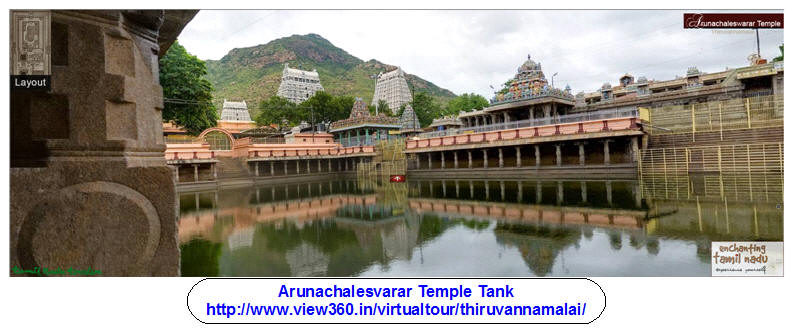
Gauri (Parvati), the consort of Siva was pleased to hear Siva’s glories from Gautama. She said to Gautma, “The deities receive boons on earth from fiery Linga and thus the earth must be superior to heaven. I will become the beloved of Siva. I will perform penance.” The sage arranged for penance. She, of delicate frame and the daughter of Mountain, wore tree barks on her bare weighty protruding breasts, and matted hair; she shone like a sapphire gem in her embodied form; her lotus eyes were sparkling; she followed to the letter all the rites of Agamas and Nigamas. The lady with slender frame stood the rigors of penance; she looked like a gem-laden effulgent creepe
Anadilinga = Anadi + Linga = without beginning + Linga. Also it is known as swyambhu or self-existent. Anadhilinga is supernatural Linga-shaped outcroppings as a natural formation from the earth. These are not fashioned by human hand. Anadhi Lingas are present at Vaidyanatha, Tarakesvara and Chandrasekara (Chittacong).
Alinga, Linga, Lingalinga
Alinga: The Great Supreme Vyaktam, the unmanifest, is beyond the ancient atma Mahan, which is beyond intelligence, the essence of the mind; the latter is beyond the mind, which is beyond the senses. Beyond avyaktam is the person who is all-pervasive and devoid of any mark (alinga). Knowing him brings liberation and immortality. Linga consists of prakrtic elements such as buddhi, ahamkara, manas, indriyas and Tanmatras (intellect, ego, mind, sense organs and subtle elements); the Supreme is not tainted with these factors; therefore, it is not subject to Samsara (= Metempsychosis). Linga status marks manifest Isvara, while Alinga status carries no marks and is unknowable; it is avyaktam, primordial, undifferentiated, unmanifest, noumenal state. Eyes have never seen this form. He can be known by (spiritual) heart, mind and (spiritual) wisdom. Mental focus helps apprehend Reality. When the five senses (vision, hearing, taste and speech, touch and grasp) and the mind come to a standstill and the intellect does not stir, that is the highest state (Paramam). When the prakrti-bound senses and the mind come to an arrest, the spiritual world that lies beyond the grasp of the senses comes into access. This is yoga; it needs control of the senses; distractions make yoga come and go.
Another view:
The Linga and the icon:
Siva Linga is attributeless Nirguna Brahman. It is point of coalescence, where all Tattvas merge and is transcendental. Nataraja is the Saguna Brahman, the clinical Entity with attributes and the wielder of all Tattvas and Prakrti.
Threefold Siva:
Some others look at Siva in three forms: Mahesa, Sadasiva, and Nishkala Siva. Mahesa is Sakala form, having body parts, a clinical form; Sadasiva is Misra rupa (mixed form), both with and without attributes; Nishkala (Nirguna) Siva has no form or attributes and it is full of Bliss; therefore, it is called Ananda Rupa (Bliss form). In Dance festival (Nritotsava = Nrit +Utsava = Dance Festival), it is the (Ananda Tandava) Bliss Dance by Nishkala Siva.
Many Lingams:
Configuration of various Lingams are based on the Bhutas or elements: Fire, Earth, Wind, Water and Sky or Ether. The idea is that Siva exists in all elements; thus he exists in your body.
| Element | Lingam | Place |
| Fire | Fire Lingam | Tiruvannamalai |
| Earth | Earth Lingam | Kanchipuram |
| Wind | Wind Lingam | Kalahasti |
| Water | Water Lingam | Jambukeshvar (Trichy) |
| Sky or Ether | Sky Lingam | Chidambaram |
When the curtain to Chit Sabah (Hall of Consciousness) in Chidambaram is drawn, what you see is an empty space representing Sky Lingam; this is the Chidambara Rahasyam (the Secret of Chidambaram); the Lord exists in all the apparently empty spaces from the atom to the vast spaces of cosmos; thus, he is the Cosmic Dancer. The Red Mountain of Tiruvannamalai is the Fire Lingam.
| நின்மலன் = The one who is Pure = Siva.
When Siva remains as Pati, He is without any of the three forms described below. Pati is beyond words and mind, full of compassion and when Pati decides, on account of his Grace to the souls, to perform the five acts of Creation, Maintenance, Destruction, Obscuration and Grace; at that instance Pati takes on the form (Sakalam). That body is not the corporeal body--கருமேனி-- as we have.
The Form of Siva is called Sakalam--சகளம். Sakalam is the aspect of Šiva as having form, represented by the images. This aspect of Siva is concerned with creation and bringing things into existence Formless aspect of Siva is Nitkalam--நிட்களம். Nitkalam is the formless aspect of Šiva. This form is concerned with ஒடுக்கம் -- involution or death. Form-formless Body is known as Sakala-Nitkala body--சகள-நிட்களம். Sakala-Nitkalan is the aspect of Siva as being with and without form, represented by the Linga. ஒடுக்கம் = Involution, as of the elements one into another; absorption, dissolution, disappearance, as of salt in water. |
Linga Worship by gods and others, Linga material, and their respective mantras.
Skanda Purana Chapter 13 tells that anyone who abandons worshipping of Siva, abandons the nectar from his hand and chases a mirage. This universe is Siva and Sakti marked with Linga and Bhaga; they are Rudra and Ambika, the Father and the Mother; anyone abandoning them and making offerings to manes has less merit. Verses 144b-194 indicate the beings, the Lingas they worship, and the mantra japas. This is not a full list--listed 58/100. The Mantras constitute Satarudriya (100 names of Rudra or Siva). Visvakarman, the celestial carpenter, is the designer and manufacturer of Lingas of disparate material for the Devas.
| Brahma | Sanaka | Saptarishis | Indra | The Sun | The Moon | Fire god | Sukra |
| Hataka linga | Krishna (black) Linga | Darbha Linga | Adamantine Linga | Copper Linga | Pearl Linga | Sapphire Linga | Ruby Linga
|
| Jagatpradhana | Visvayonika | Visvatman | Visvasrj | Jagatpati | Visvesvara | Visvakarman |
| Kubera | Visvedevas | Wind god | Vasus | The Mothers | Raksasas | Guhyas | Jaigisavya |
| Golden Linga | Silver Linga | Brass Linga | Bell-metal Linga | three metal Linga | iron Linga | Lead Linga | Brahmarandhra Linga |
| Isvara | Jagatam Pati | Sambhu | Svayambhu | Bhutesa | Bhutabhavyabhavodbhava | Yoga | Yogesvara |
| Nimi | Dhanvantari | Gandhravas | Raghava | Bana | Varuna | Nagas |
| Lingas in his two eyes | Gomaya linga | Timber Linga | Lapis Lazuli Linga | Emerald Linga | Crystal Linga | Coral Linga |
| Sarva | Sarvalokesvaresvara | Sarvasrestha | Jagajjyestha | Vasistha | Paramesvara | Lokatryamkara |
| Bharati | Sani | Ravana | Sidddhas | Bali | Maricipas |
| Taralinga | Sangamavrta | Jasmine plant Linga | Manasa Linga | Linga of gleaned grains | Flower Linga |
| Lokatriyasrita | Jagannatha | Sadurjaya | Kamamrtyujaritiga | Jnanatman | Jnanagamaya |
| Kapila | Devas | Kama | Saci | Viswakarman | Vibhisana |
| Valukalinga | Gold Linga | Jagary Linga | Salt Linga | Prasada Linga | Dust Linga |
| Varada | Sitikantha | Ratida | Babhurukesa | Yamaya | Suhrttama |
| Lakshmi | Yogins | Humans | Urvasi | Siddha Yoginis | Dakinis |
| Lepya Linga | all-pervasive Linga | all kinds of Linga | red lead linga | Sandalwood Linga | Mamsa-Linga |
| Harinetra | Sthanu | Purusamnaman | Priyavasana | Sahasraksa | Midhusa |
| Manus | Agastya | Valmiki | Daityas | Dasnavas | Clouds |
| Anna Linga | Rice grain Linga | Valmika (ant hill) | Black mustard Linga | Wind Linga | Nira (H2O) Linga |
| Girisa | Susanta | Ciravasi | Ugra | Dikpati | parjanyapati |
| Skanda | Yama | Mandhata | Cows | Birds | Earth |
| Stone Linga | Black iron Linga | Sugar Linga | Milk Linga | Sky Linga | Merulinga |
| Senanya | Dhanvin | Bahuyuga | Netrasahasraka | Sarvatmaka | Dvitanu |
| Pasupati | Brahmanas | Vasuki | Padma | Sages | Goddess Siva | |
| Sacred Ash Linga | Brahmalinga | Visa Linga | Srngi Linga | Knowledge Linga | Mercury Linga | |
| Mahesvara | Jyestha | Sankara | Dhurjati | Cirasthana | Tryambaka |
If one wants Purusarthas (virtue, wealth, love, and liberation), Hara-Siva should be worshipped. He brings all three worlds to his devotee.
Siva is Sunya, worshipped by Yogis; the yogic path is very difficult to follow to reach Sunya. Those who want to enjoy worldly pleasures should worship the visible and palpable Linga. (Skanda Purana I.ii.33.25-34)
Skanda Purana i.II.33.27... says bathing Linga in pure water, the whole universe from Brahma to a blade of grass is propitiated. Bathing Linga with Pancamrita is tantamount to bathing and propitiating the Pitrs. Offering seasonal flowers in worship of Linga is worshipping the whole universe. If a talented man offers Naivedya to Linga, it is tantamount to feeding the whole universe. Whatever is offered to linga in worship, large or little, brings joy to all. As Agni is the all-devouring mouth of devas, linga is the mouth of all worlds. Installation of Linga in a temple gives logarithmic benefits with each successive construction. Constructing a rounded pinnacle on top of the temple gives a place in the world of Rudra till the end of Kalpa for him and 21 generations in his family.
Please go to Mahisasura which is continuation of The Red Mountain.
Skanda Purana and the manifestation of Taijasa Linga--Arunachala in the words of Brahma to Sanaka, one of the mind-born sons of Brahma (Sanaka, Sanandana, SanAtana, SanatkumAra), as narrated by Sri Suta.
Taijasa Linga is pure and Refulgent Linga, destroys enemies of human race such as lust and anger, and manifested itself in the continent of Jambu. Narayana and Brahma are the sons of Siva-Sadasiva according to Skanda Purana and Saivites. Brahma adn Narayana were fighting with each other about the supposed superiority of one over the other. The preceding passages explains the superiority of Siva over both of them. Siddhas and leading Suras (gods) leave their abodes, Meru Mountain and Kailasa, go to Arunachala, and wait there for salvation: that is its greatness.
